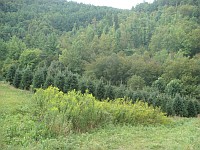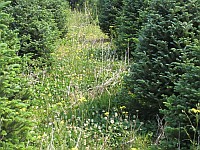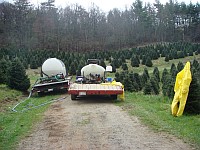Focus on Mite Control
go.ncsu.edu/readext?297876
en Español / em Português
El inglés es el idioma de control de esta página. En la medida en que haya algún conflicto entre la traducción al inglés y la traducción, el inglés prevalece.
Al hacer clic en el enlace de traducción se activa un servicio de traducción gratuito para convertir la página al español. Al igual que con cualquier traducción por Internet, la conversión no es sensible al contexto y puede que no traduzca el texto en su significado original. NC State Extension no garantiza la exactitud del texto traducido. Por favor, tenga en cuenta que algunas aplicaciones y/o servicios pueden no funcionar como se espera cuando se traducen.
Português
Inglês é o idioma de controle desta página. Na medida que haja algum conflito entre o texto original em Inglês e a tradução, o Inglês prevalece.
Ao clicar no link de tradução, um serviço gratuito de tradução será ativado para converter a página para o Português. Como em qualquer tradução pela internet, a conversão não é sensivel ao contexto e pode não ocorrer a tradução para o significado orginal. O serviço de Extensão da Carolina do Norte (NC State Extension) não garante a exatidão do texto traduzido. Por favor, observe que algumas funções ou serviços podem não funcionar como esperado após a tradução.
English
English is the controlling language of this page. To the extent there is any conflict between the English text and the translation, English controls.
Clicking on the translation link activates a free translation service to convert the page to Spanish. As with any Internet translation, the conversion is not context-sensitive and may not translate the text to its original meaning. NC State Extension does not guarantee the accuracy of the translated text. Please note that some applications and/or services may not function as expected when translated.
Collapse ▲Mites can quickly cause damage, making trees nearing market unsalable. However, their numbers can also just as quickly crash, making pesticide applications unnecessary. Through proper cultural practices, the need for mite control can usually be avoided because the predatory mites are favored over the mite pests.
Cultural Controls
Cultural practices affect mite control more than any other pest of Fraser fir Christmas trees because mites reproduce so quickly. But mite numbers can crash just as quickly given environmental conditions that favor the natural enemies of mites, particularly predatory mites. Most of the cultural factors listed here are those that help favor natural controls over the mite pests.
Site Selection
 Most of the cultural practices to reduce mite pressure are related to site selection. Good sites that do not favor SSM are cooler and moister. Therefore, fields lower than 3,000 feet in elevation, that face south or southwest, or that are on a windy exposed site have more problems with SSM.
Most of the cultural practices to reduce mite pressure are related to site selection. Good sites that do not favor SSM are cooler and moister. Therefore, fields lower than 3,000 feet in elevation, that face south or southwest, or that are on a windy exposed site have more problems with SSM.
Ground Cover Management
 Ground covers provide habitat for natural predators of mites. They also help moderate temperatures and increase humidity. Keep a living and flowering ground cover around trees.
Ground covers provide habitat for natural predators of mites. They also help moderate temperatures and increase humidity. Keep a living and flowering ground cover around trees.
Not only do ground covers around trees provide a habitat for predators, so do field borders. In fact, field borders of briars and woody stemmed plants are some of the best habitat for predatory mites. Keep field borders in an early successional state by bush hogging every 2 to 3 years.
Pesticide Use for Other Pests
 Pesticides that are broad-spectrum such as the synthetic pyrethroids (Asana, Astro, Sniper, Talstar, and Wisdom) can create more problems with HRM and even SSM. Yet these materials are the main-stay for control of EHS, BWA, BTA and Cinara aphids. Timing appears to be key with these products. Using them in the fall creates less impact on natural predators. If you use these products in the spring or summer, just be aware that SSM and HRM numbers can rebound.
Pesticides that are broad-spectrum such as the synthetic pyrethroids (Asana, Astro, Sniper, Talstar, and Wisdom) can create more problems with HRM and even SSM. Yet these materials are the main-stay for control of EHS, BWA, BTA and Cinara aphids. Timing appears to be key with these products. Using them in the fall creates less impact on natural predators. If you use these products in the spring or summer, just be aware that SSM and HRM numbers can rebound.
When Chemical Control Is Necessary
Trees need to go to market with two years of undamaged foliage. Mite damage seldom becomes so great that it reduces tree growth. Therefore, if the trees won’t be harvested for more than 2 years, consider not treating for mites unless the incidence is extremely high.
Mite numbers are dynamic. The SSM can go from an egg to an adult capable of reproducing in as little as two weeks. Numbers can also crash just as quickly when rainfall and high humidity create conditions favorable to predatory mites. If you are finding predatory mites or other predators or if rain is forecast, consider not treating for mites.
It is important to use a miticide only when necessary. There are two reasons for this. First of all, miticides are very expensive. Secondly, there are concerns that mites will develop resistance to miticides since they reproduce so quickly. Because of the risk of resistance, many miticide labels state that they can only be applied once in a growing season. Another good way to reduce the risk of resistance is to not use the same miticide year after year.
Chemical Control of Mites
The SSM and HRM are different biologically from each other and not all miticides are effective against them. In addition, different miticides control different stages of mites. Some only kill the adults and immatures. Others only have activity against the eggs or immatures and do not affect adults. These are typically chemicals that affect how the mite molts.
The following is a list of miticides and their activity.
| Miticide | Common Name / Family | Decription |
|---|---|---|
| Apollo | Clofentezin Chemical family: Unknown mite growth inhibitor | Apollo controls the eggs and immatures of spruce spider mite in a manner similar to Savey. It has no activity against hemlock rust mites. Only apply this material once per year. |
| Avid | Abemectin Chemical family: avermectin | This miticide is quickly absorbed by the plant and kills the mite as it feeds. Since it remains in the plant for 2 weeks or more, it should kill any mites that hatch from eggs, even though it has no activity against the egg itself. The material paralyzes mites by increasing the release of the inhibitory neurotransmitter gamma aminobutryric acid (GABA) from nerve terminals inside the pest. After spraying, mites may appear normal, but they cannot feed or cause damage and within a few days they die. However, field control has been mixed in western North Carolina. Controls both spruce spider mite and hemlock rust mite. May have some activity against aphids. |
| Cinnamite | Cinnamaldehyde | This material kills mites on contact. Eggs are not affected. To achieve good results, two applications made 10 to 14 days apart will be necessary. Also has some activity against the balsam twig aphid. |
| Dimethoate | Dimethoate Chemical family: organophosphate | This is a nerve poison. It has activity against both spider mites and rust mites. It does not control the mite egg and needs to be reapplied in 10 to 14 days if mite eggs are present when trees are treated. It also controls the balsam twig aphid and rosette bud mite (when applied during shoot elongation) and will help reduce elongate hemlock scale. To achieve good scale control, mix with other products such as Asana (esfenvalerate). |
| Envidor | Spirodiclofen Chemical family: tetronic acid derivative | Envidor is a limpid biosynthesis inhibitor. It has activity against both rust mites and spider mites and lasts long enough to control the immatures that hatch from the eggs. Use it at the higher labeled rate to control spider mites and the lower rate to control only rust mites. This product has the following on the label: “This product is toxic to honey bee larvae through direct contamination of pollen and nectar. Do not apply to blooming, pollen-shedding or nectar-producing parts of plants if bees forage on the plants.” |
| Floramite | Bifenazate Chemical family: carbazate | This material also acts as a GABA inhibitor. It is persistent in plant foliage for more than 21 days. It is active against all stages of mites. Field trials in Fraser fir have been mixed and Floramite is only active against the tetranychid or spider mites. |
| Horticultural Oil | Horticultural oils kill mites and insects by smothering them. May have some limited activity against the spider mite egg but may have to be reapplied within 10 to 14 days. Control against rust mites is as good as other miticides at a 2% solution. Most oils are petroleum based, but some are vegetable based. Horticultural oil can burn foliage if agitation is not adequate. Encapsulated oils do not cause problems with burn. | |
| Lorsban | Chlorpyrifos Chemical family: organophosphate | This is a nerve poison. It does not control the mite egg and needs to be reapplied in 10 to 14 days if mite eggs are present when trees are treated. Also controls the balsam woolly adelgid, balsam twig aphid, and hemlock rust mite. |
| Ornamite | Propargite | This material works by contact so thorough coverage is necessary. |
| Sanmite | Pyridaben Chemical family: pyridazinone | This material, which works on contact, is a mitochondrial electorn transport inhibitor (METI), which blocks cellular respiration, causing the pest to lose coordination and eventually collapse. It also controls the hemlock rust mite. |
| Savey | Hexythiazox | This material controls the mite eggs and immature spruce spider mite but has little activity against the adult. The pest is controlled when it either walks across the residues on needles, or an egg is laid on the residue. It interferes with the mite’s ability to produce the chitin in its exoskelton. Either apply this material when about 10 to 25 % of the mite eggs have hatched in the spring and no adults are present, or mix with another miticide which doesn’t control mite eggs, such as dimethoate. This product has no activity against hemlock rust mite. Only apply this material once per year. |
| Talstar (Sniper) | Bifenthrin Chemical family: synthetic pyrethroid | Talstar has activity against spider mites but not rust mites. It lasts long enough on the foliage to kill the immatures that hatch from the eggs. However, use of Talstar often creates subsequent problems with rust mites. |


